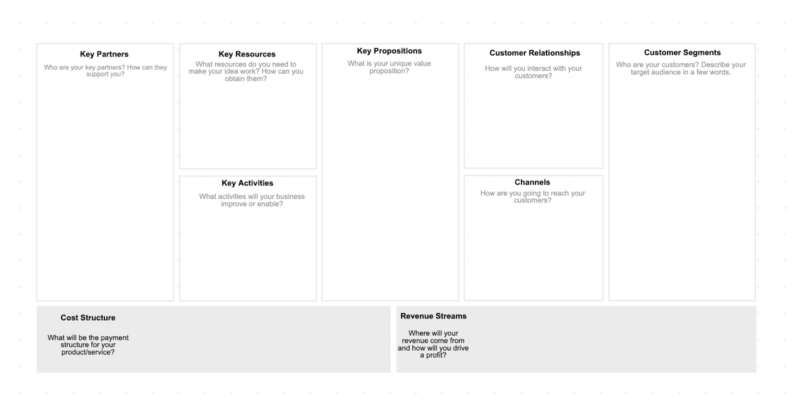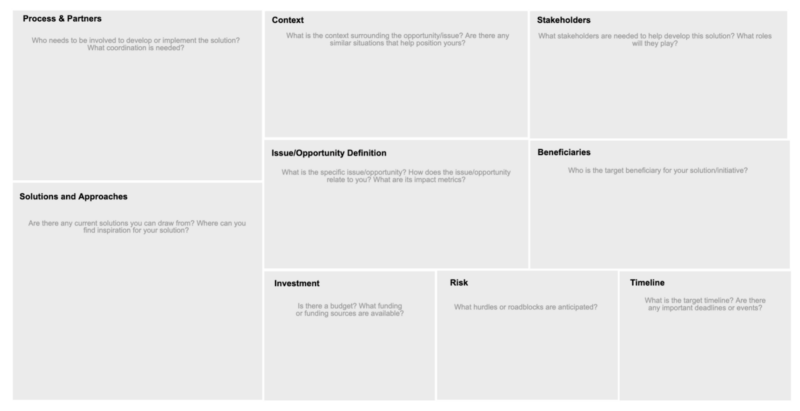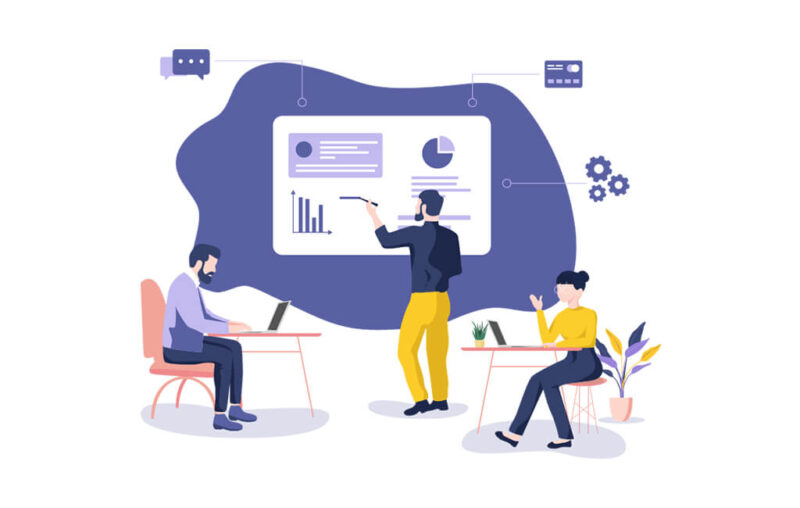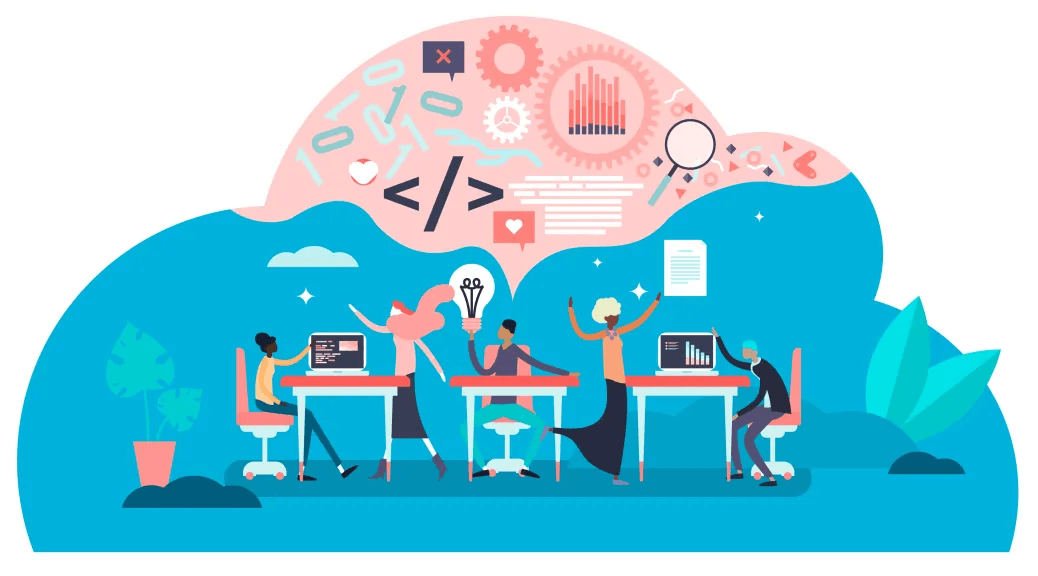Table of Contents
Using a Business Model Canvas has become one of the premium alternatives to dragging one out on paper. These boards make creating and interpreting business plans or go-to-market strategies a collaborative endeavor and something anyone can create.
This article will define what a business model canvas is and discuss its various advantages, and how to use them, and walk you through our very own business model canvas. If you're interested in learning more about our other template definitions, you can look at our guides on Kanban, customer journey maps, and SWOTs.
What is a Business Model Canvas?
A business model canvas is defined as an organizational tool that helps visualize the development of a potential business model. It describes the components required to successfully take a business to market.
The end goal of using a business model canvas is to gain a better understanding of a target customer base, how to drive a profit, and how to deliver a unique value proposition. These are some of the key components to using a business model canvas and must be defined in order to achieve a successful go-to-market strategy.

Business model canvases are an effective alternative to the traditional method of documenting a business plan, which is usually presented in long multi-page documents.
These templates make the core elements of a business plan more palatable and easy to understand while providing quick visualizations of these pieces of information. When used through an online whiteboard like IdeaScale Whiteboard, it also enables collaboration on these items, inherently making the results more accurate and informed.
The Business Model Canvas consists of nine building blocks, each representing a critical aspect of a business:
- Customer Segments: Identifying the specific groups of customers or market segments a business aims to serve.
- Value Proposition: Describing the unique value or benefits that the business offers to its target customers.
- Channels: Explaining the methods and channels used to reach and interact with customers to deliver the value proposition.
- Customer Relationships: Outlining the type of relationships and interactions the business establishes and maintains with its customers.
- Revenue Streams: Identifying the sources of revenue and how the business plans to generate income from its customers.
- Key Resources: Listing the essential assets, skills, and resources required to operate the business.
- Key Activities: Identifying the critical tasks and actions the business must perform to deliver its value proposition and generate revenue.
- Key Partnerships: Describing any external entities or organizations that the business collaborates with to strengthen its business model.
- Cost Structure: Detailing the costs and expenses incurred in operating the business.
9 Business Model Canvas Examples
Once you completely understand why to use a business model canvas, it's time to dive into the methodology behind each step. In this section, we will explain how to properly plan for success on a business model canvas.
1. Key Partners
Questions to ask: "What are your key partners to getting a competitive advantage?"
This question prods at the possible strategic partnerships to align your business with in order to gain an advantage over the competition. This could be certain people, other companies, or any type of collaborative partnership.
It's important to consider partnerships when developing a business plan because they will eventually not only come in handy but be necessary for the growth and publicity of the business. They can also serve as an early advantage and can push a small business forward at exponential levels.
2. Key Resources
Questions to ask: What resources are needed to make your idea work? If you don't already have these resources, what steps can be taken to obtain them?
Resources are one of the biggest drivers of change within a business, and it's important to recognize which resources you have and which resources you need. By thinking about the resources you need to create a business, you tangentially focus on the steps that need to be taken in order to get it off the ground. The resources play directly into that and will affect how you are able to strategically create your plan.
3. Key Activities
Questions to ask: What activities will your business enable for customers?
This is effectively where you detail the product/service that is being provided. When thinking about what activities your business enables or improves, you are inherently thinking about the customer's journey and what they will experience as a user.
The product/service that users interact with will be the driving force for the entire business, so it's important to have a solid understanding of what this will be and how exactly they will use it. While thinking about the product/service is important, you should also think about the activities that are made possible as an extension of your business. These could be tangential actions or actions done in collaboration with other businesses. All of these scenarios are examples of how your business enables and improves other activities.

4. Key Propositions
Questions to ask: What is your unique value proposition? What do you bring to your customer's lives that weren't present before? How do you make their life/job easier?
The value proposition should be one of the most fleshed-out details of the entire business model because it is the core reason for creating the business. Without a value proposition, there is no meaning behind the business and customers will not feel like they can identify and find loyalty with your brand.
The value proposition should be something that is both in demand and unique. It doesn't have to be an entirely unique idea, but it does have to have some kind of defining feature to make it stand out. This gives customers a reason to use your product/service over another. Because of the importance and centrality of the entire business model, the unique value proposition should be one of the most descriptive and prioritized sections of the template.
5. Customer Relationships
Questions to ask: How will you manage interactions with your current and potential customers? How will you get your value proposition across to them?
Building and maintaining customer relationships is key to a successful business plan, and thinking about these interactions in advance is greatly helpful in communicating your team goals and expectations. It can be easy to assume customer interactions will happen naturally, but especially when starting a business there has to be a strong push to facilitate these interactions.
It's equally important to think about how you will allow your value proposition to shine through in these instances. This unique element to your business is ideally what will attract new customers and provide demand to those who are currently using your product/service. It's important to think about ways to provide this information when planning your interactions so that your customers understand your special features.
6. Channels
Questions to ask: How are you going to reach your customers? What channels of communication will you utilize?
For this point, think about the various ways you will plan to reach your customers. This could be through direct outreach, word of mouth, blog posting, advertising, or any other medium. These outlets will generate different unique interactions with different customer bases and should be considered to optimize your outreach.
7. Customer Segments
Questions to ask: Who is your business targeting? Describe your target audience in a few words.
This section is meant to highlight the specific persona that your business is targeting. Think about the profile that defines your target audience, and write these details in a couple of notes.
This is arguably one of the most important sections in the business model canvas because this principal user will define your entire strategy and method of outreach. They are the end goal of the business plan and many of your features will eventually be catered to their needs. It can be smart to pair this part of the template with a Persona Map in order to gain the deepest understanding of your principal user that you possibly can.
8. Cost Structure
Questions to ask: What are you planning to spend on marketing and product development? Are you planning to charge for your product/service?
The final two points are meant to be logistic markers for how you plan to operate the financials of your business plan. Firstly, you must think about the marketing, development, and advertising costs of creating your business. These can be fixed or dynamic depending on how you want to set up your business. Next, think about the pricing structure of your product/service. Will it be a SaaS service? Will people pay for it or will it be free? These are important things to consider when thinking about your business's cost structure.
9. Revenue Streams
Questions to ask: Where will the money come from? How will these revenue streams drive profits?
Revenue streams are effectively how your business makes a profit and the exact location of where this money comes from. Mainly, it should be coming from a point detailed in the cost structure (how you charge for your product/service). Think about the specific cost structure and how that will end up driving a profit for your business.
Learn more: What is Lean Canvas?
Business Model Canvas Explained
Here are five explanations of how the Business Model Canvas can be applied to various types of businesses:
1. E-commerce Business
- Customer Segments: Online shoppers, B2B buyers, wholesale customers.
- Value Proposition: Wide product selection, convenience, fast shipping, competitive pricing.
- Channels: Utilizing online platforms including the website, mobile application, social media, and email marketing.
- Customer Relationships: Self-service, automated support, personalized recommendations.
- Key Activities: Inventory management, online marketing, website maintenance.
- Key Resources: E-commerce platform, warehouse, delivery partners.
- Key Partners: Suppliers, payment processors, and delivery companies.
- Revenue Streams: Product sales, subscription fees, advertising.
2. Software as a Service (SaaS) Company
- Customer Segments: Small businesses, enterprises, educational institutions.
- Value Proposition: Scalable cloud-based software, cost-effective solutions, and regular updates.
- Channels: Website, free trials, sales team, online communities.
- Customer Relationships: Online support, account managers, knowledge base.
- Key Activities: Software development, customer onboarding, support and updates.
- Key Resources: Development team, servers, customer data.
- Key Partners: Cloud service providers, integration partners, and resellers.
- Revenue Streams: Subscription fees, premium features, consulting services.
3. Restaurant Business
- Customer Segments: Locals, tourists, event planners, food delivery services.
- Value Proposition: Delicious cuisine, welcoming ambiance, special events.
- Channels: Physical location, online reservations, food delivery apps.
- Customer Relationships: In-person service, reservation systems, loyalty programs.
- Key Activities: Food preparation, staff training, marketing, event hosting.
- Key Resources: Kitchen equipment, skilled chefs, dining space.
- Key Partners: Local suppliers, food delivery platforms, and event organizers.
- Revenue Streams: Food and beverage sales, event hosting fees, catering services.
4. Subscription Box Service
- Customer Segments: Subscription box enthusiasts, gift buyers, and niche hobbyists.
- Value Proposition: Curated selection, surprise factor, convenience.
- Channels: Website, social media, influencer partnerships.
- Customer Relationships: Subscription management, customization options, feedback loops.
- Key Activities: Product curation, packaging, logistics, and customer support.
- Key Resources: Product suppliers, subscription management software, warehouse.
- Key Partners: Product suppliers, shipping companies, influencers.
- Revenue Streams: Subscription fees, one-time purchases, affiliate marketing.
5. Freemium Mobile App
- Customer Segments: Casual users, power users, and businesses.
- Value Proposition: Free basic functionality, premium features, and convenience.
- Channels: App stores, social media, referral programs.
- Customer Relationships: In-app support, user communities, push notifications.
- Key Activities: App development, updates, user data analysis.
- Key Resources: Development team, user data, servers.
- Key Partners: App stores, advertisers, third-party integrations.
- Revenue Streams: In-app purchases, advertising, premium subscriptions.
These are just a few examples of how the Business Model Canvas can be used to describe different types of businesses. The canvas can be customized and adapted to fit the specific needs and characteristics of any business model.
Learn more: 4 Key Business Model Canvas Advantages
Business Model Canvas Channels
In the Business Model Canvas, the "Channels" component refers to the various ways a business reaches and interacts with its customers in order to deliver its value proposition. It encompasses the distribution and communication methods used to make products or services accessible to the target market. Channels can be both physical and digital, and they play a crucial role in shaping the overall business model. Here are some common examples of channels:
- Direct Sales: The business sells its products or services directly to customers through its own sales team or physical stores. For example, a luxury jewelry brand may operate high-end boutiques to sell its products directly to customers.
- Online Sales: Products or services are sold through an e-commerce website or mobile app. For instance, Amazon and eBay primarily operate through online sales channels.
- Retail Stores: Businesses may use physical retail stores, such as supermarkets, malls, or specialty shops, to sell their products directly to customers.
- Wholesale: Businesses may sell their products in bulk to other businesses (wholesalers or distributors), who then resell them to retailers or end consumers.
- Franchise: Franchise businesses utilize a network of franchisees who operate their own outlets, using the parent company's brand and business model. Examples include fast-food chains like McDonald's and Subway.
- Marketplaces: These are platforms that connect buyers and sellers. Examples include Amazon Marketplace, eBay, and Etsy, where individual sellers list and sell products to a broader audience.

- App Stores: Mobile app stores like the Apple App Store and Google Play Store provide a platform for businesses to distribute and sell mobile applications directly to users.
- Agent/Broker: Intermediaries, such as real estate agents or insurance brokers, help connect buyers with sellers and facilitate transactions.
- Social Media: Social media platforms like Facebook and Instagram can serve as channels for businesses to reach customers, advertise products, and interact with their audience.
- Subscription Services: Businesses may use subscription models, such as streaming services like Netflix, to provide content or access to their products or services on a regular basis.
- Content Marketing: Businesses create valuable content to attract and engage potential customers. This can include blogs, videos, and podcasts distributed through websites or social media.
- Events and Trade Shows: Participating in industry-specific events and trade shows can be an effective channel to showcase products, generate leads, and network with potential customers.
- Telecommunications: Businesses can use phone and email channels to communicate with customers, provide customer support, and even take orders.
- Third-Party Platforms: Businesses may leverage third-party platforms and marketplaces, such as Airbnb or Uber, to reach a wider audience without having to create their own platform from scratch.
- Brick-and-Click: A combination of physical and digital channels, where customers can shop both in physical stores and online, with features like in-store pickup and online ordering.
The choice of channels depends on the nature of the business, the target audience, and the specific industry. Effective channel selection is essential for reaching and engaging with customers to deliver the value proposition and generate revenue. Businesses may use multiple channels in a multi-channel strategy to optimize their market reach and customer experience.
Learn more: What is Mind Map?
Key Resources of Business Model Canvas
In the Business Model Canvas, "Key Resources" refers to the essential assets, capabilities, and infrastructure that a business needs to create, deliver, and capture value. These resources are fundamental to the business model and help define the core competencies and advantages of the company. The key resources vary depending on the type of business and industry, but here are some common examples:
1. Physical Assets:
- Manufacturing facilities
- Equipment and machinery
- Inventory and stock
- Real estate and facilities
2. Intellectual Property:
- Trademarks, patents, and copyrights
- Proprietary technology or software
- Trade secrets and know-how
3. Human Resources:
- Skilled employees and management
- Expertise and specialized knowledge
- Training and development programs
4. Financial Resources:
- Capital and funding
- Lines of credit or loans
- Cash reserves
5. Networks and Partnerships:
- Strategic alliances and partnerships
- Supplier relationships
- Distribution networks
6. Brand and Reputation:
- Brand recognition and reputation
- Customer loyalty
- Positive reviews and testimonials
7. Customer Data:
- Customer databases and profiles
- Market research and customer insights
- Feedback and analytics
8. Technological Infrastructure:
- Data centers and server infrastructure
- Software and IT systems
- Communication networks
9. Distribution and Logistics:
- Supply chain and logistics networks
- Transportation and delivery resources
- Warehousing and storage facilities
10. Unique Processes:
- Proprietary production processes
- Innovative research and development methods
- Efficient operational procedures
11. Reputation and Trust:
- Strong relationships with stakeholders
- Regulatory approvals and certifications
- A track record of reliability and quality
12. Content and Intellectual Capital:
- A library of content (e.g., books, music, videos)
- Expertise in a particular domain
- Educational materials or courses
13. Legal and Regulatory Permissions:
- Licenses and permits to operate
- Compliance with industry regulations
- Exclusive rights to operate in a certain region
14. Geographical Presence:
- Strategic locations or access to specific markets
- Regional or global presence
- Local knowledge and connections
15. Physical Locations:
- Retail stores, offices, or service centers
- Pop-up shops or event spaces
- Showrooms or experience centers
Selecting and managing key resources effectively is critical for the success of a business. These resources support the business model's value proposition, help it achieve a competitive advantage, and enable the efficient operation of the business. The specific combination of key resources can vary widely depending on the business's industry, strategy, and objectives.
Learn more: Lean Canvas vs. Business Model Canvas
Conclusion
Using a business model canvas is one of the best ways to create a comprehensive business plan, and as we've shown, is only made better by using an online whiteboard. If you want to see more IdeaScale Whiteboard content make sure to check out our guest-written blog posts on Lander and TryMyUI blogs.
Most Recent Posts
Explore the latest innovation insights and trends with our recent blog posts.













